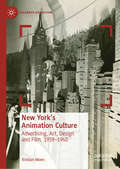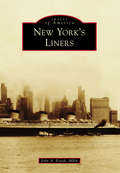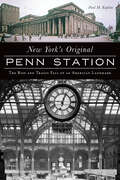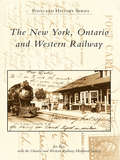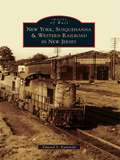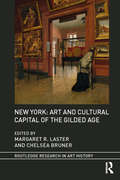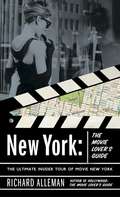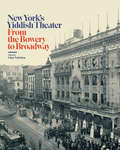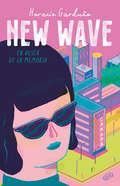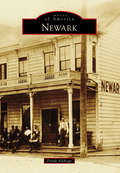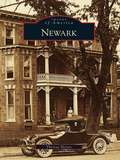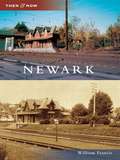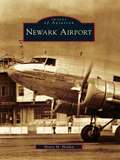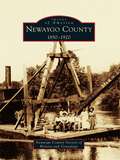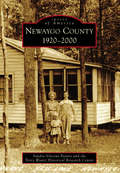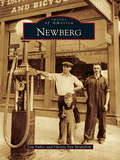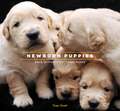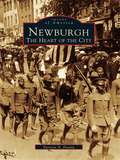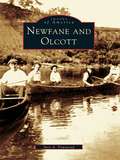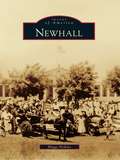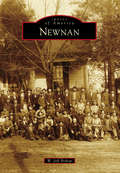- Table View
- List View
New York's Animation Culture: Advertising, Art, Design and Film, 1939–1940 (Palgrave Animation)
by Kristian MoenThis book reveals and explores the thriving animation culture in midtown Manhattan, the World’s Fair, art galleries and cinemas during a vibrant period of artistic, commercial and industrial activity in New York City. Alongside a detailed investigation of animated film at the time – ranging from the abstract works of Mary Ellen Bute and Norman McLaren to the exhibition practices of the Disney Studios and the New York World’s Fair – New York’s Animation Culture examines a host of other animated forms, including moving dioramas, illuminated billboards, industrial displays, gallery exhibitions, mobile murals, and shop windows. In this innovative microhistory of animation, Moen combines the study of art, culture, design and film to offer a fine-grained account of an especially lively animation culture that was seen as creating new media, expanding the cinema experience, giving expression to utopian dreams of modernity, and presenting dynamic visions of a kinetic future.
New York's Golden Age of Bridges
by Antonio Masi Joan Marans DimIn New York’s Golden Age of Bridges, artist Antonio Masi teams up with writer and New York City historianJoan Marans Dim to offer a multidimensional exploration of New York City’s nine major bridges, their artistic andcultural underpinnings, and their impact worldwide.The tale of New York City’s bridges begins in 1883, when the Brooklyn Bridge rose majestically over the East River, signaling the start of America’s “Golden Age” of bridge building. The Williamsburg followed in 1903, the Queensboro (renamed the Ed Koch Queensboro Bridge) and the Manhattan in 1909, the George Washington in 1931, the Triborough (renamed the Robert F. Kennedy Bridge) in 1936, the Bronx-Whitestone in 1939, the Throgs Neck in 1961, and the Verrazano-Narrows in 1964. Each of these classic bridges has its own story, and the book’s paintings show the majesty and artistry, while the essays fill in the fascinating details ofits social, cultural, economic, political, and environmental history.America’s great bridges, built almost entirely by immigrant engineers, architects, and laborers, have come to symbolize not only labor and ingenuity but also bravery and sacrifice. The building of each bridge took a human toll. The Brooklyn Bridge’s designer and chief engineer, John A. Roebling, himself died in the service of bridge building. But beyond those stories is another narrative—one that encompasses the dreams and ambitions of a city, and eventually a nation. At this moment in Asia and Europe many modern, largescale, long-span suspension bridges are being built. They are the progeny of New York City’s Golden Age bridges. This book comes along at the perfect moment to place these great public projects into their historical and artistic contexts and to inform and delight artists, engineers, historians, architects, and city planners. In addition to the historical and artistic perspectives, New York’s Golden Age of Bridges explores the inestimable connections that bridges foster, and reveals the extraordinary impact of the nine Golden Age bridges on the city, the nation, and the world.
New York's Liners
by John A. FostikFor 175 years, passenger ships have crossed the Atlantic, linking the Old World with the New World. Between 1892 and 1954, more than 12 million immigrants passed through the port of New York. National rivalries caused ships to grow in size, speed, and a comfort that had once been unimaginable. The advent of the passenger jet in 1958 changed how people travel. New York's harbor is now quieter, and there are no longer days with six liners ready to sail to fabled European ports. Happily, one can still sail to Europe, cruise the Caribbean, or take a world cruise from Manhattan aboard a new generation of liners like the Queen Mary 2. New York's Liners captures iconic images of the great ships from the 1890s to the present day.
New York's Original Penn Station: The Rise and Tragic Fall of an American Landmark (Landmarks)
by Paul M KaplanThe story of the spectacular and much-lamented train terminal whose destruction inspired a new passion for historic preservation. Includes photos. In early twentieth-century New York, few could have imagined a train terminal as grand as Pennsylvania Station. Yet, executives at the Pennsylvania Railroad secretly bought up land in Manhattan's infamous Tenderloin District to build one of the world's most spectacular monuments. Sandhogs would battle the fiercest of nature to build tunnels linking Manhattan to New Jersey and Long Island. For decades, Penn Station was a center of elegance and pride. But the ensuing rise of the airplane and automobile began to diminish train travel. Consequently, in the mid-1960s, the station was tragically destroyed. The loss inspired the birth of preservation laws in the city and the nation that would save other landmarks—such as New York&’s Grand Central, just blocks away. Here, Paul Kaplan recounts the trials and triumphs of New York's Penn Station, with extensive photos and illustrations.
New York, Ontario and Western Railway, The
by Joe Bux Ontario and Western Railway Historical SocietyThe New York, Ontario and Western Railway was the first class-one railroad in the United States to be abandoned in its entirety. Whereas other rail lines were closed gradually, the federal government closed down the railroad on March 29, 1957, for its failure to pay employee withholding taxes. The railroad went into bankruptcy in 1937 after its main shipping commodity, coal, was rapidly replaced by oil for home heat. As time passed, the interest in this abandoned railroad grew, and much of the company's records have been recovered and preserved. Today, with 750 members, the Ontario and Western Railway Historical Society Archives Center houses this unique corporate record collection. In addition, there are extensive private collections of everything from locomotives, passenger cars, lanterns, and tools to company passes and railroad police memorabilia.
New York, Susquehanna & Western Railroad in New Jersey
by Edward S. KaminskiOriginally incorporated in 1881, the New York, Susquehanna & Western Railroad has had a long history in New Jersey. The railroad expanded by the early 1890s into the thriving Pennsylvania coalfields and eventually grew to over 200 miles of trackage in the northern portion of New Jersey. Always viewed as an underdog in a marketplace surrounded by much larger railroads, the New York, Susquehanna & Western emerged from 40 years of Erie Railroad control; survived several bankruptcies, reorganizations, abandonments, and retrenchments through innovative passenger and freight service offerings; and transformed into today's regional rail carrier with a size far greater than ever imagined.
New York: Art and Cultural Capital of the Gilded Age (Routledge Research in Art History)
by Margaret R. Laster Chelsea BrunerFueled by a flourishing capitalist economy, undergirded by advancements in architectural design and urban infrastructure, and patronized by growing bourgeois and elite classes, New York’s built environment was dramatically transformed in the 1870s and 1880s. This book argues that this constituted the formative period of New York’s modernization and cosmopolitanism—the product of a vital self-consciousness and a deliberate intent on the part of its elite citizenry to create a world-class cultural metropolis reflecting the city’s economic and political preeminence. The interdisciplinary essays in this book examine New York’s late nineteenth-century evolution not simply as a question of its physical layout but also in terms of its radically new social composition, comprising the individuals, institutions, and organizations that played determining roles in the city’s cultural ascendancy.
New York: The Movie Lover's Guide
by Richard AllemanThe classic guide to who-did-what-where in New York, on- and off-screen, including: Classic film and TV locations: Marilyn Monroe's infamous Seven Year Itch subway grating . . . the deli where Meg Ryan famously faked an orgasm in When Harry Met Sally . . . the diner where Courteney Cox (in Friends) and Kirsten Dunst (in Spider-Man) waitressed . . . Men in Black's Manhattan headquarters . . . The Godfather mansion on Staten Island...the Greenwich Village apartment where Jack Nicholson terrorized Greg Kinnear in As Good as It Gets . . . Ghostbusters' Tribeca firehouse . . . Michael Douglas and Gwyneth Paltrow's A Perfect Murder palazzo . . . the landmark West Side building that housed Tom Cruise in Vanilla Sky and Mia Farrow in Rosemary's Baby . . . the Greenwich Village apartment of Friends . . . Will & Grace's Upper West Side building . . . The All in the Family block in Queens . . . The Sopranos' New Jersey mansion (and the real Bada Bing club) . . . Seinfeld's favorite diner . . . Sex and the City's sexiest haunts . . . and many more . . . Stars' childhood homes: Lena Horne's Bedford-Stuyvesant townhouse . . . Frank Sinatra's Hoboken row house . . . Barbra Streisand's Flatbush housing project . . . J.Lo's Bronx block . . . Humphrey Bogart's Upper West Side tenement . . . the Marx Brothers' Upper East Side brownstone . . . Apartments and townhouses of the silver screen's greatest legends: Joan Crawford . . . Marlene Dietrich . . . James Dean . . . Katharine Hepburn . . . Montgomery Clift . . . Rita Hayworth . . . Rock Hudson . . . and . . . Plus: Superstar cemeteries . . . major film and TV studios . . . historic movie palaces and Broadway theaters . . . star-studded restaurants and legendary hotels . . . For movie-loving New Yorkers, travelers and armchair film buffs, New York: The Movie Lover's Guide is the ultimate insider's guide to the Big Apple's reel attractions.
New York’s Yiddish Theater: From the Bowery to Broadway
by Edna NahshonIn the early decades of the twentieth century, a vibrant theatrical culture took shape on New York City's Lower East Side. Original dramas, comedies, musicals, and vaudeville, along with sophisticated productions of Shakespeare, Ibsen, and Chekhov, were innovatively staged for crowds that rivaled the audiences on Broadway. Though these productions were in Yiddish and catered to Eastern European, Jewish audiences (the largest immigrant group in the city at the time), their artistic innovations, energetic style, and engagement with politics and the world around them came to influence all facets of the American stage. Vividly illustrated and with essays from leading historians and critics, this book recounts the heyday of "Yiddish Broadway" and its vital contribution to American Jewish life and crossover to the broader American culture. These performances grappled with Jewish nationalism, labor relations, women's rights, religious observance, acculturation, and assimilation. They reflected a range of genres, from tear-jerkers to experimental theater. The artists who came of age in this world include Stella Adler, Eddie Cantor, Jerry Lewis, Sophie Tucker, Mel Brooks, and Joan Rivers. The story of New York's Yiddish theater is a tale of creativity and legacy and of immigrants who, in the process of becoming Americans, had an enormous impact on the country's cultural and artistic development.
New to You: How to Buy, Fix, and Keep Secondhand Clothing
by Melody FortierSick of cheap, wasteful, disposable fast fashion? Learn how to shop for vintage clothing and accessories and build a more sustainable, stylish closet. In this indispensable guide, anyone who buys or wears women&’s clothing will learn how to:• Avoid overpaying• Sort trash from treasure• Fix minor flaws—and spot major ones• Find your ideal silhouette (including tips for plus-size shoppers)• Alter and repurpose garments• Care for delicate vintage fabricsBuying older clothing means getting beautiful pieces that are built to last, without contributing to sweatshops or landfills—but only if you know what to look for. Let a vintage clothing expert guide you to ethical fashion bliss!Previously published as The Little Guide to Vintage Shopping in 2009, this updated edition includes a new introduction and resources for evaluating online and brick-and-mortar shops.
New wave. En busca de la memoria
by Horacio GarduñoTres chicos, un mal recuerdo perdido en el limbo y una banda post punk. Lucrecia canta en una banda punk y se expresa con intensidad inusual, con una energía brutal en el escenario, y vaya que tiene un mundo interior por manifestarse, pues su vida en casa no ha sido fácil. La música es su vía de desfogue. En su mente hay otra Lucrecia, más inocente, que ha olvidado su pasado a causa de una experiencia traumática. Pero cuando conoce a Juan José, un baterista que se deja llevar por el trance de la música, las cosas empiezan a reacomodarse de forma extraña. Lucre busca recuperar sus memorias y las escribe en una libreta. Pero aún debe ahondar en ciertos recuerdos, los más dolorosos. Un día llegan dos personas al hoyo funky donde debuta su banda, una del pasado de Lucre y otra de su futuro, ambas la harán entrar en un dilema que la enfrentará con aquello que tanto teme. Explora los viajes y las subrealidades de la mente humana en el tiempo y en el espacio. Una nueva ola de la vida a pesar de los goles recibidos.
Newark
by Frank AddiegoOften overlooked as a minor enclave surrounded by the sprawling suburb of Fremont and confused with its New Jersey namesake, Newark, California, has been a hub of innovation commercially, industrially, and technologically, even before it officially became a city in 1955. While Newark had already been home to factories and chemical plants, citizens were reticent to allow the small town to become an industrial section of the city and thus opted out of an ambitious plan among several hamlets to become Fremont. Since then, it has become a functioning city unto its own with its own infrastructure and a passionate constituency whose spirit has made Newark a friendly city but never a boring one.
Newark
by Theresa HesseyDuring the past 250 years, Newark has transformedfrom a tiny farming community into a thriving small city. Its history includes the arrival of a variety of industries--including paper, woolen, and fibre mills and an automobile manufacturing plant--that have expanded the city's commercial and economic opportunities. Newark has also been home to the University of Delaware from its beginnings as a small academy in 1767. As a result, Newark's history is interwoven with that of the university. Althoughmany of the industries that once thrived in Newark have closed because of technological advances and shifting economies, the city continues to grow. Main Street is now the retail hub of the city, and stores reside in what were private residences. Despite all of the changes brought on by industry and the passage of time, Newark has maintained its small-town feel.
Newark
by William FrancisNew Ark, as it is pronounced and appeared on colonial maps, is located in New Castle County near the borders of Pennsylvania and Maryland. Scotch-Irish and Welsh settlers developed Newark as a market town around the intersection of two Lenni Lenape trails. Newark remained little more than a village throughout its history, reaching a population of only 11,000 by 1960. Today it is over 30,000, with an additional 15,000 students at the University of Delaware.
Newark Airport (Images of Aviation)
by Henry M. HoldenNewark Airport was the first major airport in the New York metropolitan area. It opened on October 1, 1928, occupying an area of filled-in marshland. In 1935, Amelia Earhart dedicated the Newark Airport Administration Building, which was North America's first commercial airline terminal. Newark was the busiest airport in the world until LaGuardia Airport, in New York, opened in 1939. During World War II, Newark was closed to passenger traffic and controlled by the United States Army Air Force for logistics operations. The Port Authority of New York took over the airport in 1948 and made major investments in airport infrastructure. It expanded, opened new runways and hangars, and improved the airport's terminal layout. The art deco administration building served as the main terminal until the opening of the North Terminal in 1953. The administration building was added to the National Register of Historic Places in 1979.
Newaygo County: 1850-1920
by Newaygo County Society of History and GenealogyPioneers in Newaygo County were motivated by the call of adventure and a chance to make a fortune in the vast wilderness. The first settlers came to lumber the virgin white pine that grew in the Newaygo forests. The Muskegon River flowed through the region and, along with the White River and many creeks and lakes, offered a major waterway to float logs to Lake Michigan. As early as 1837, Newaygo loggers were floating logs to market, becoming large contributors to the lumbering industry. Lumber from Newaygo County was used to rebuild Chicago after the Great Fire of 1871. In 1851, legislature gave Newaygo independence to form a county and Newaygo County entered a growth spurt that continues to this day. With the coming of the railroad in 1872 and a rapid increase in population, small settlements started popping up. As areas became logged out, many of these settlements died and have been long forgotten; many others remained and thrive today. Newaygo County: 1850-1920 preserves the history of these settlements and the people who built them.
Newaygo County: 1920-2000 (Images of America)
by Sandra Vincent Peavey Terry Wantz Historical Research CenterPeople moved into Newaygo County to farm, as the terrain offered beneficial conditions for planting crops and orchards, and eventually the area developed into several interwoven farming communities. Once agriculture took root, others businesses and crafts found a marketplace within county limits, and Newaygo began to grow while still maintaining a sense of hometown warmness and caring. Residents are proud of their heritage and history and know how to enjoy the surrounding natural beauty regardless of the season.
Newberg
by Christy Van Heukelem Tom FullerThe land that became the city of Newberg played a crucial role in the founding of the state of Oregon. It provided the second permanent encampment after Fort Astoria for trappers coming to the Pacific Northwest. Ewing Young came to Oregon in 1834, claiming as his own a vast stretch of land around his home in the Chehalem Valley. When Ewing died without a will, nearby residents gathered to settle Ewing's estate. This event led directly to the vote at Champoeg to make Oregon part of the United States. The town's name was given by pioneer Sebastian Brutscher after his Bavarian hometown of Neuburg. Other settlers arrived, and soon Newberg was a thriving pioneer town. Among the new settlers were members of the Friends Church, who set up an academy that is today one of the premier Christian universities in the country. Newberg was also home or way station to two U.S. presidents.
Newborn & Maternity Photography: Learn the Skills and Build a Business
by Kristina MackHave you always dreamt of turning your photography hobby into a business, but don't feel you have the skills or accumen to succeed? Newborn and maternity photography is one of the fastest-growing businesses for photographers to move into, and with a seasoned pro as your guide you can quickly learn the secrets of success. In this book, acclaimed newborn and maternity photographer Kristina Mack shares her knowledge of the creative and practical aspects of the genre, and also the tricky business of making a living from capturing this unique stage of the human experience.
Newborn & Maternity Photography: Learn the Skills and Build a Business
by Kristina MackHave you always dreamt of turning your photography hobby into a business, but don't feel you have the skills or accumen to succeed? Newborn and maternity photography is one of the fastest-growing businesses for photographers to move into, and with a seasoned pro as your guide you can quickly learn the secrets of success. In this book, acclaimed newborn and maternity photographer Kristina Mack shares her knowledge of the creative and practical aspects of the genre, and also the tricky business of making a living from capturing this unique stage of the human experience.
Newborn Puppies
by Traer ScottDog lovers who haven't raised puppies from birth have missed out on one of the most remarkable and adorable times in a dog's life. From one to twenty-one days old, puppies undergo great changes, from needing their mothers' complete care to opening their eyes and ears to the outside world, growing, stretching their legs, and learning to become the dogs that they are. Author/photographer (and new mother) Traer Scott's love of dogs shines through these intimate images of a range of breeds and types, from champion pups to shelter strays, all of them irresistible. Including an introduction on puppies' development and the importance of their welfare, this delightful book reveals young dogs as they embark on the adventures of growing up.
Newburgh: The Heart of the City
by Patricia A. FavataNewburgh: The Heart of the City focuses on one of the widest thoroughfares in the Northeast, Broadway, the main street in Newburgh, measuring one hundred thirty-two feet across. Known as "the heart of the city," Broadway was the activity center in the twentieth century. It was lined with government offices, commercial and business enterprises, schools, churches, restaurants, firehouses, farms, fortune-tellers, and entertainment and recreational establishments. Broadway was not only the street of everyman but also the street of presidents, playing host to both Franklin D. Roosevelt and John F. Kennedy.
Newfane and Olcott
by Avis A. TownsendNewfane and Olcott are adjoining communities in western New York where residents relish the past and look toward a prosperous future. Some say they can hear the music of the big bands playing along the shoreline of Lake Ontario from the foundation of the long-demolished Olcott Beach Hotel. Others swear they can see the ghost of Malinda standing by the upstairs window of the beautiful Van Horn Mansion, guarding the grounds where her body was lost for one hundred fifty years.
Newhall
by Maggi PerkinsNewhall's many firsts include the first gold discovery in California and the first commercially successful oil well, which led to the first pipeline and oil refinery in California. Some of the earliest movie location filming was done here. First recorded by Juan Crespi on the Sacred Expedition of 1769, the Little Santa Clara Valley was recognized by the Spanish as an important junction between the mountain ranges separating Northern and Southern California. The early city fathers of Los Angeles saw the settlement of Newhall as an integral part of their strategy for growth from the days of the stagecoach and railroad through to the building of Ridge Route and Interstate 5. This book tells the story of the town that never quite lived up to its potential but still managed a varied history with a colorful cast rivaling those of the movies filmed here.
Newnan (Images of America)
by W. Jeff BishopNewnan, founded in 1828 in the rolling Piedmont section of west Georgia, has long been known as the "City of Homes." While many small towns in the South have been burned, bulldozed, or transformed by industry and development, Newnan retains much of its 19th-century charm and elegance, including more than a dozen restored antebellum homes and a 1904 courthouse on the downtown square. The town produced two of Georgia's most progressive governors and provided writer Erskine Caldwell with his earliest, formative memories. Newnan is the small town that country music singer (and native son) Alan Jackson immortalized in his hit song "Little Man"; in these pages, readers will see the "old Lee King's apothecary" and other downtown buildings that Jackson found so inspiring during his childhood.
